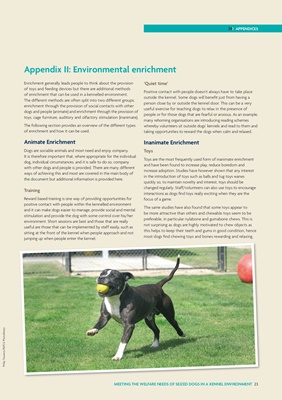
��� APPENDICES
Enrichment generally leads people to think about the provision
of toys and feeding devices but there are additional methods
of enrichment that can be used in a kennelled environment.
The different methods are often split into two different groups:
enrichment through the provision of social contacts with other
dogs and people (animate) and enrichment through the provision of
toys, cage furniture, auditory and olfactory stimulation (inanimate).
The following section provides an overview of the different types
of enrichment and how it can be used.
Animate Enrichment
Dogs are sociable animals and most need and enjoy company.
It is therefore important that, where appropriate for the individual
dog, individual circumstances, and it is safe to do so, company
with other dogs and people is provided. There are many different
ways of achieving this and most are covered in the main body of
the document but additional information is provided here.
Training
Reward based training is one way of providing opportunities for
positive contact with people within the kennelled environment
and it can make dogs easier to manage, provide social and mental
stimulation and provide the dog with some control over his/her
environment. Short sessions are best and those that are really
useful are those that can be implemented by staff easily, such as
sitting at the front of the kennel when people approach and not
jumping up when people enter the kennel.
'Quiet time'
Positive contact with people doesn't always have to take place
outside the kennel. Some dogs will benefit just from having a
person close by or outside the kennel door. This can be a very
useful exercise for teaching dogs to relax in the presence of
people or for those dogs that are fearful or anxious. As an example,
many rehoming organisations are introducing reading schemes
whereby volunteers sit outside dogs' kennels and read to them and
taking opportunities to reward the dogs when calm and relaxed.
Inanimate Enrichment
Toys
Toys are the most frequently used form of inanimate enrichment
and have been found to increase play, reduce boredom and
increase adoption. Studies have however shown that any interest
in the introduction of toys such as balls and tug toys wanes
quickly so, to maintain novelty and interest, toys should be
changed regularly. Staff/volunteers can also use toys to encourage
interactions as dogs find toys really exciting when they are the
focus of a game.
The same studies have also found that some toys appear to
be more attractive than others and chewable toys seem to be
preferable, in particular nylabone and gumabone chews. This is
not surprising as dogs are highly motivated to chew objects as
this helps to keep their teeth and gums in good condition, hence
most dogs find chewing toys and bones rewarding and relaxing.
MEETING THE WELFARE NEEDS OF SEIZED DOGS IN A KENNEL ENVIRONMENT 23
Philip Toscano/RSPCA Photolibrary
Appendix II: Environmental enrichment